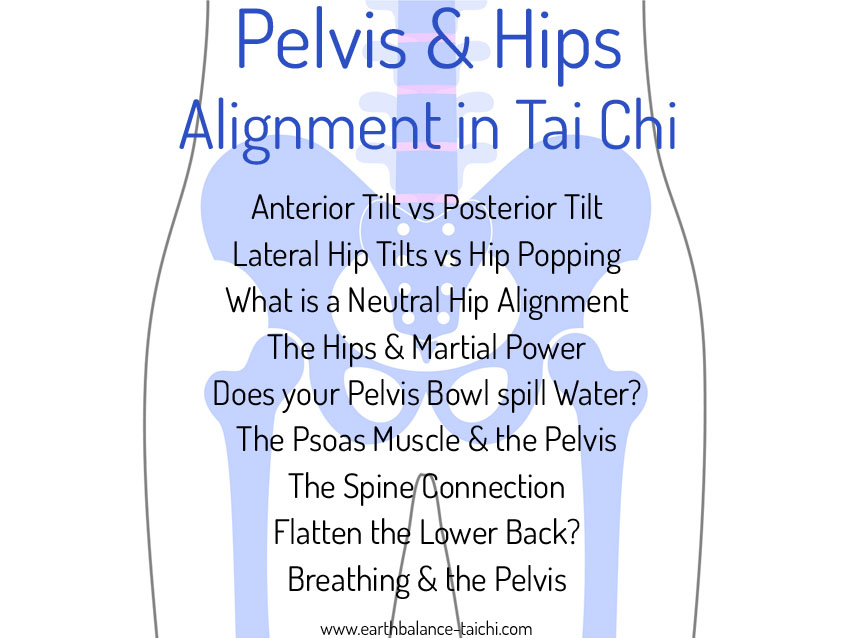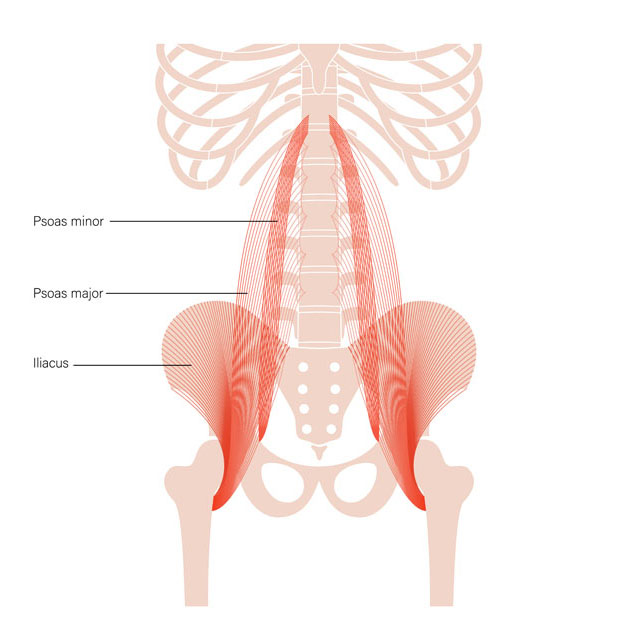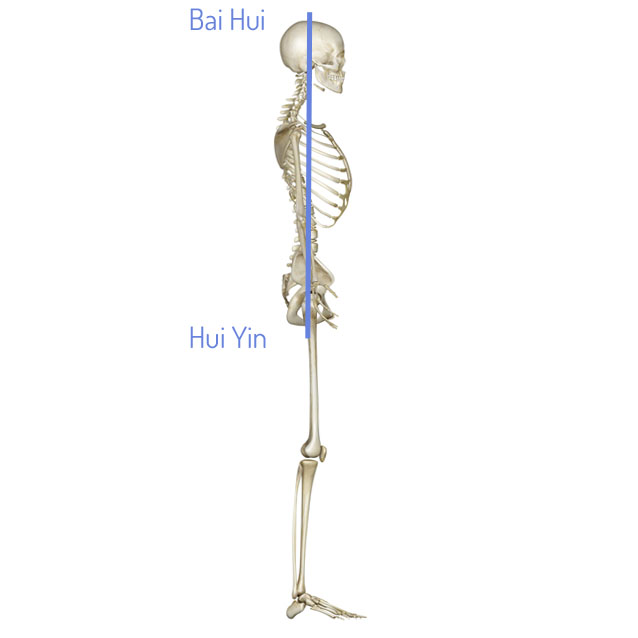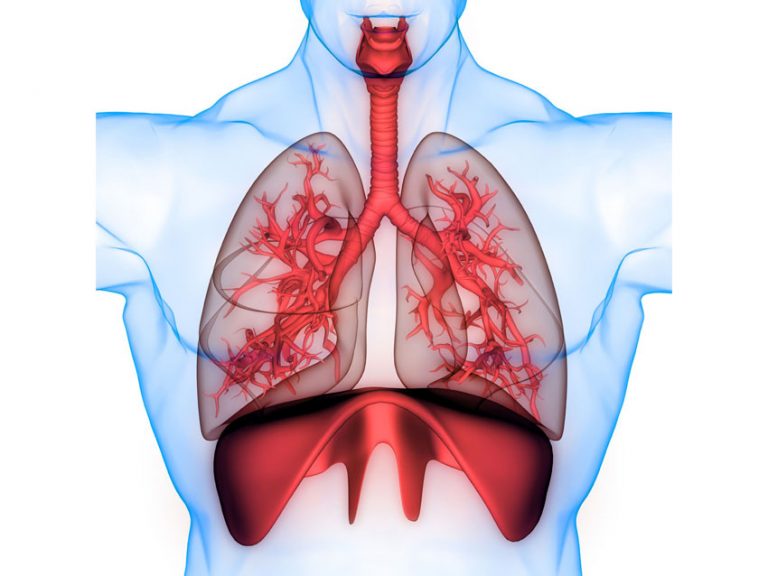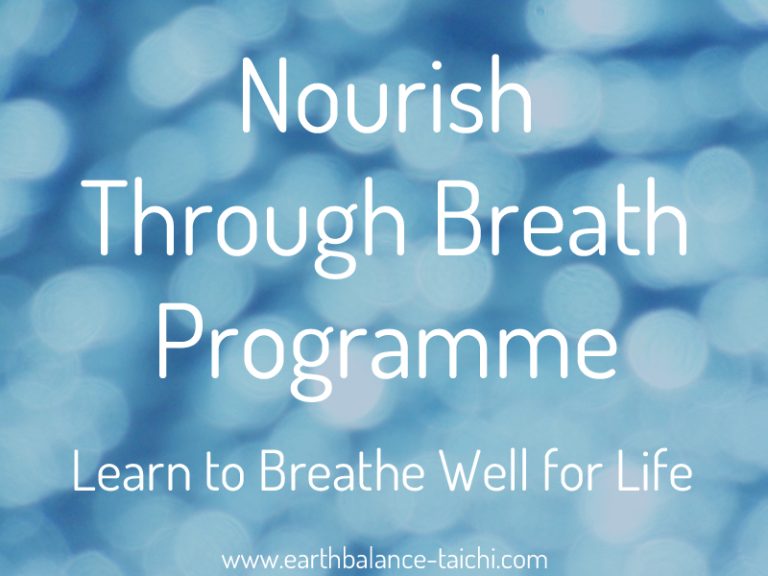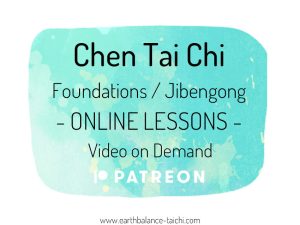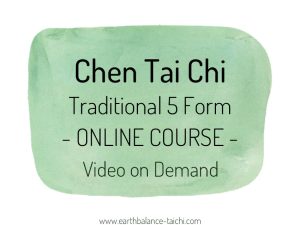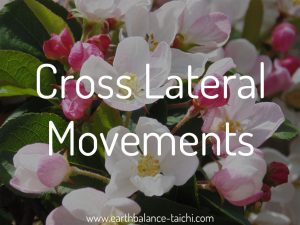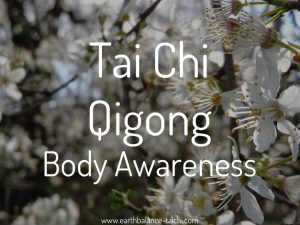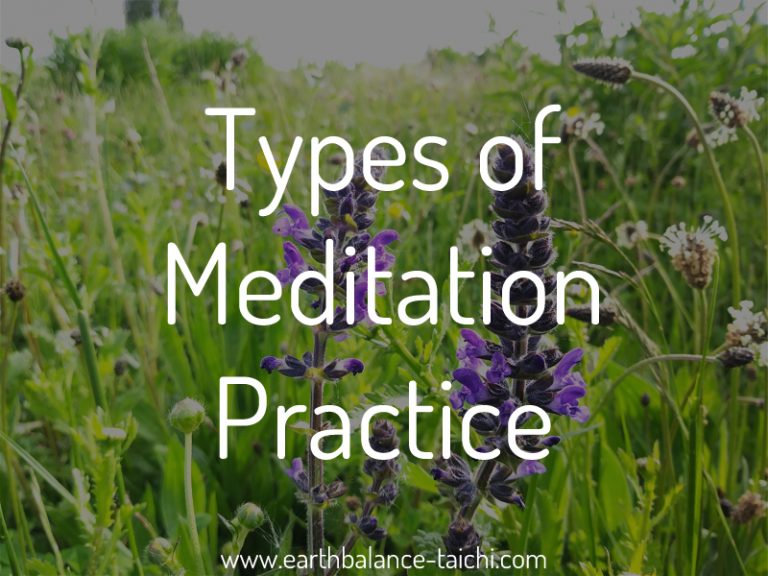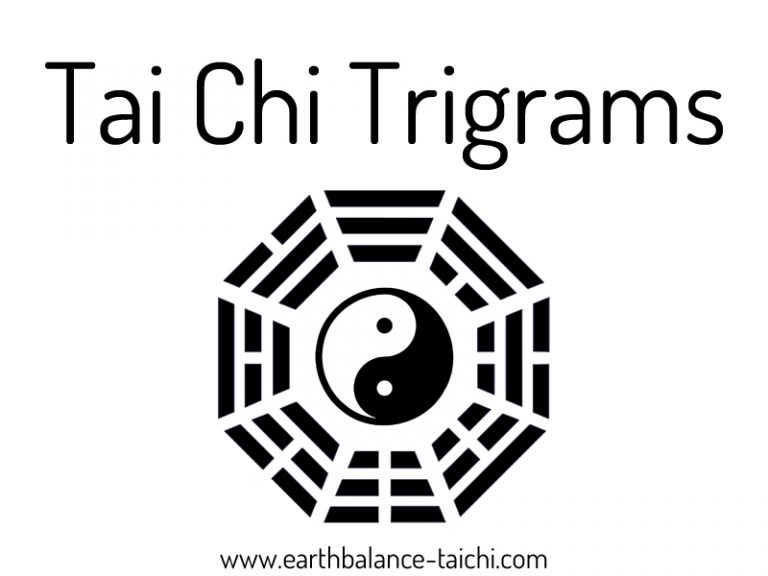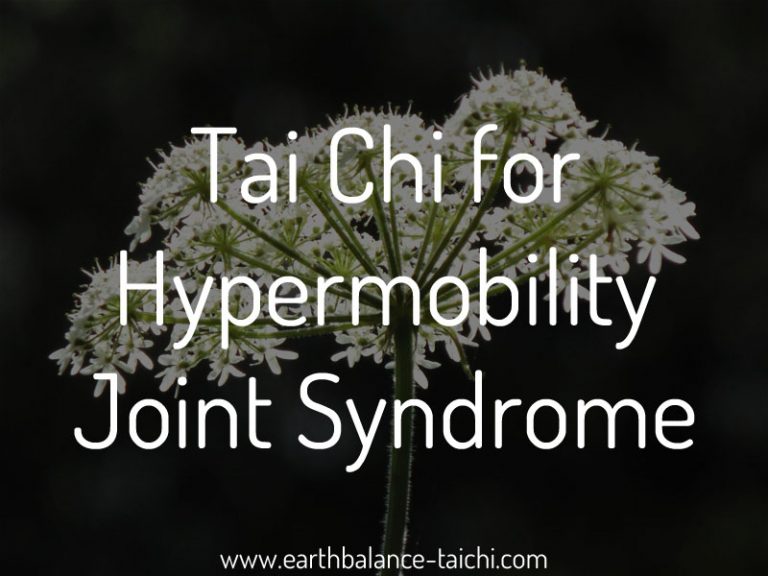The Hips in Tai Chi
The Hips in Tai Chi
The importance of aligning the pelvis and hips in your Tai Chi practice, to improve the quality of your Tai Chi movements and your ability to absorb and generate martial power. In turn, this aids your postural health, how well your organs function and your ability to breathe deeply. Aligning your structure also improves Qi and blood flow from a Traditional Chinese Medicine viewpoint. The companion article to this looks at the internal hip function and body mechanics in Tai Chi around the inguinal crease hip area, known as the kuw/kwa in Chinese (coming soon). Read more about the hips in Tai Chi here.
Cause
The cause of poor pelvis posture may be:
- Sedentary lifestyle e.g. sitting or driving for long periods.
- Poor posture becoming habit.
- Lack of body awareness.
- Wearing heels.
- Movement routine that fosters a poor posture.
- Genetics.
Anterior Tilt
Anterior tilt is when there is an excessive curve in the lower back, with the hip crests pushed forwards. This shortens the lower back muscles and pushes the buttocks outwards. It also over lengthens the hamstring muscles and the abdominal muscles, resulting in the abdomen bulging outwards.
Looking at your waist when wearing trousers, the front of the waist band is lower the than rear of the waist band. Symptoms may present as lower back pain, knee pain, weak glutes, weak abdominal muscles, short and tight hip flexors and over worked quad muscles.
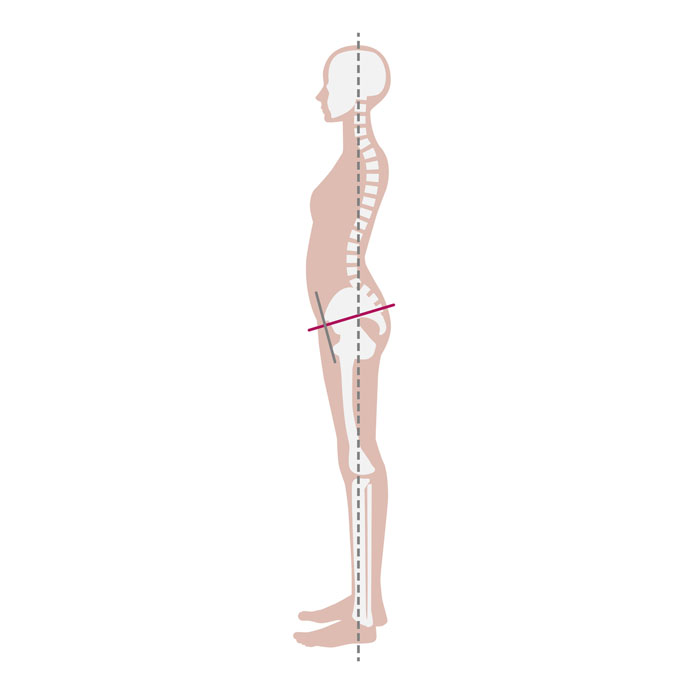
In a neutral pelvis alignment, the hips are slightly tilted forwards with around ten degrees anterior tilt for women and five degrees or less for males. In my experience as a Tai Chi and Qi Gong instructor, women have much more likelihood of an excessive anterior tilt, especially post partum.
Posterior Tilt
Posterior tilt is when there is an excessive thrusting forwards of the pelvis, with the hip crests pushed backwards. This lengthens the lower back muscles and shortens and constricts the muscles and organs on the front line of the body e.g. bladder.
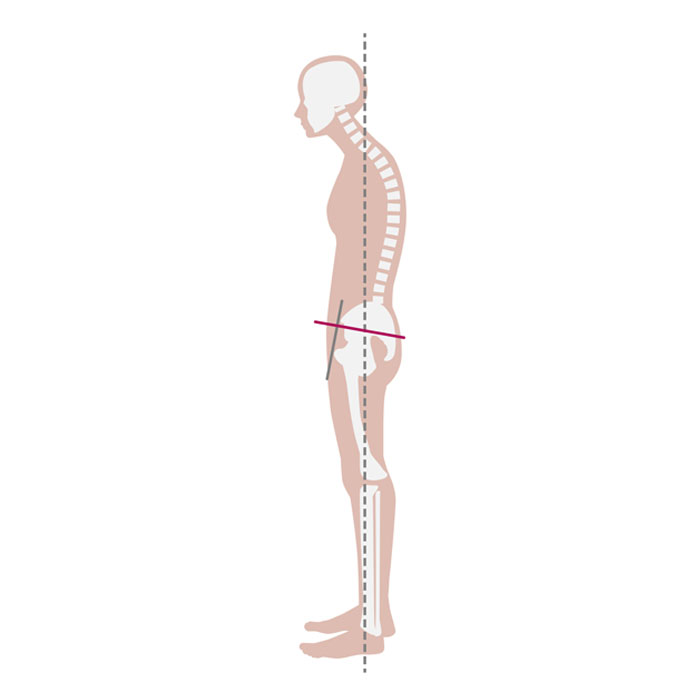
Lateral Hip Tilt
Looking at your hips square on from the front, if one of your hips raises vertically whilst the other stays still, this breaks the horizontal alignment of the hip crests in Tai Chi. When raising a hip it also usually pushes the same shoulder upwards if you are maintaining the other Tai Chi alignment principles. When taking an empty step stance, or when in a one legged stance when lifting one leg up, this is common to see. It is also common when weight shifting through the silk reeling movements. The body will try and take the pressure off the leg muscles and moves the skeleton out of alignment to compensate for being in a weighted squat. Tilting the hip crest up uproots your centre of gravity making it easy to stumble or lose balance. Part of the pelvis alignment principle is to level the hips across a horizontal plane, whether double weighted, standing on one leg, weight shifting etc.
The illustration below shows examples when standing double weighted, where the level of the hips is different in a standing posture. As with posterior and anterior tilt, this may be from an embedded habitual posture that develops over time due to disharmony in the muscular and connective tissue system. It may also be skeleton abnormalities from birth or through injury or illness. It may not be possible for a person to adjust their posture, to return to an entirely neutral skeleton position. An example would be if the person has one leg shorter than the other, when they wear bare feet, their pelvis will tilt to one side.
Pop the Hip
Looking at the hips square on from the front, if one of your hips pushes out to the side, this breaks the vertical alignment of the hip crests. This happens when the hip moves out further than the outside edge of the foot. This is most commonly seen when squatting, side stepping, lifting one leg or moving into an empty stance in Tai Chi practice.
It is easier and less tiring to pop the hip than to use the hip crease (kua) to squat into and stabilise the lower body through good alignment and appropriate muscle control. When any pressure or force travels through the body when popping the hip, you are likely to become unbalanced or stumble due to poor alignment.
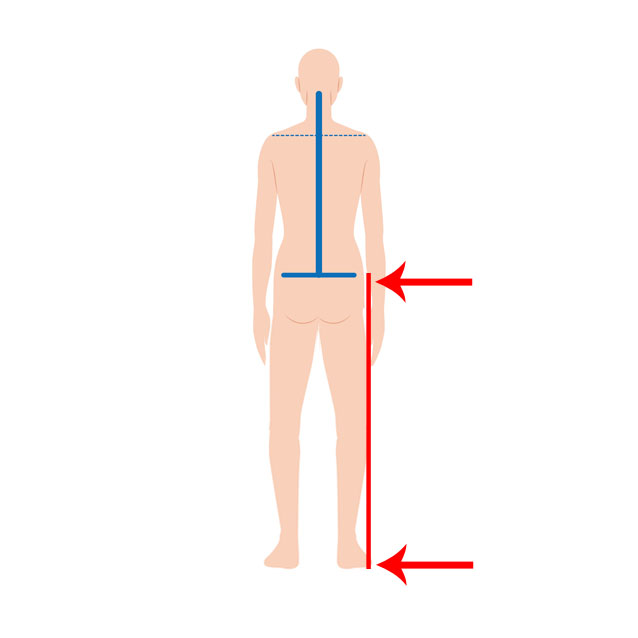
The Hips in Tai Chi - Neutral Pelvis
At the core of alignment and posture training we foster a neutral pelvis. Not anterior or posterior tilt, not lateral tilt and not popping the hip. The hips are stabilised centrally with appropriate muscle contraction and elasticity in the connective tissue.
The organs are stacked appropriately and are supported by the torso, which aids their functioning. By levelling your hips, this helps grounding and rooting in Tai Chi, and it also helps support the upper body to align over the pelvis.

In Tai Chi and Traditional Chinese Medicine alignment theory, a neutral pelvis from the profile view can be achieved by horizontally aligning the lower Dantian point with the Mingmen point.
- Dantian: 1-2 inches below navel, and 1-2 inches internally towards spine.
- Mingmen: between lumbar vertebrae 2-3.
The key with the pelvis is to balance it in six alignment directions: forwards, backwards, up, down, left, right. This neutral position is like being in neutral in a car gear stick, as in this position there is space and openness to move in any direction without hindrance.
The Hips in Tai Chi
In Tai Chi there are many descriptions to align the hips, pelvis and lower back. With the teachers I have trained with, vocabulary and concepts differ between them. Here are some phrases I have heard from my teachers and used in class.
- Bring Dantian towards Mingmen
- Open the Mingmen point
- Fill the lower back
- Lengthen the tail-bone down
- Relax the lower back
- Reduce the S curve in the lower back
- Lengthen the lumbar muscles
- Upright and straighten the spine
- Loosen the lower back
- Dangle the coccyx
- Open the lumbar spine
- Flatten the lower back
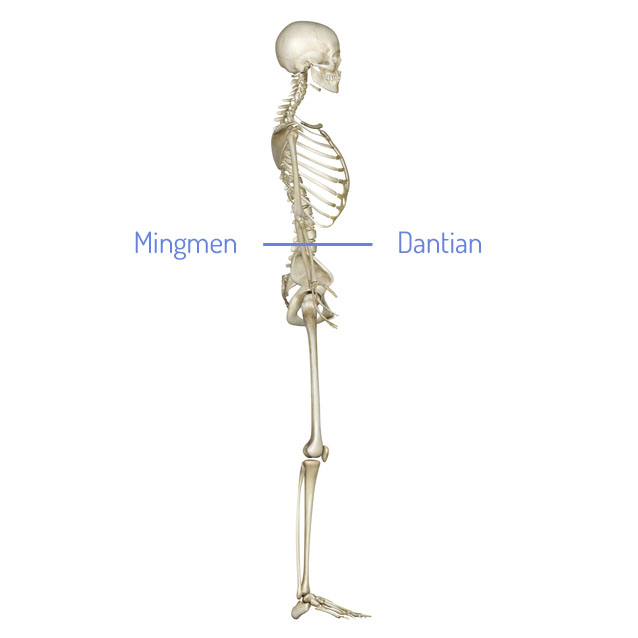
Most people have some degree of anterior tilt, with an excessive lumbar curve. This needs to be adjusted with new beginner students, so they start to align the spine more appropriately for Tai Chi practice.
A healthy posture works with gravity, where any weight or pressure transfers down to the ground through the physical structure. Any part of the skeleton that is misaligned means the weight will get stuck in a joint e.g. lower back, which over time can cause pain and injury.
There’s a difference between aligning the skeleton and activating the muscles and releasing and extending the lower back muscles to align a neutral pelvis. Beginner students start with a physical movement of the pelvis. Over time as body sensitivity, applied relaxation (fang song) and connective tissue elasticity develops, this progresses into a lengthening internal quality.
Outdated
Sayings that are now somewhat outdated in Tai Chi practice:
- Tuck the tail bone.
- Tilt or roll the pelvis under.
Without further explanation or demonstration these phrases tend to move students into an exaggerated posterior tilt without context.
One Size Fits All
The caveat when working with groups of students is to give one size fits all instructions that do not take into account each person’s habitual posture. If the instructor asks everyone to tuck the tail-bone under, this may cause an excessive posterior tilt to someone whose habitual posture is posterior tilt. Each student needs to be observed by an instructor before recommending how to align a neutral pelvis. The ideal is for the instructor to give hands on adjustment of their pelvis, so the student can feel a more appropriate alignment. An example would be, for a student that is in an excessive anterior tilt, finding neutral would be moving towards posterior tilt, which would help activate the glute muscles, shorten the hamstrings and stabilise the spine. Some students may need be sign posted to a physiotherapist, chiropractor or osteopath to check any underlying muscular skeletal involvement in their structure.
The Hips in Tai Chi - Pelvis Bowl
A neutral pelvis can be likened to a bowl of water. When aligned correctly the bowl of water does not spill during stillness or movement. If the pelvis moves to anterior tilt, the water would spill over of the front of the bowl. If the pelvis moves to posterior tilt, the water would spill over the back of the bowl. When raising one of the hips upwards in a lateral hip tilt, the water would spill over either the left or right side of the bowl. When the hips and pelvis are stabilised, the water does not spill.
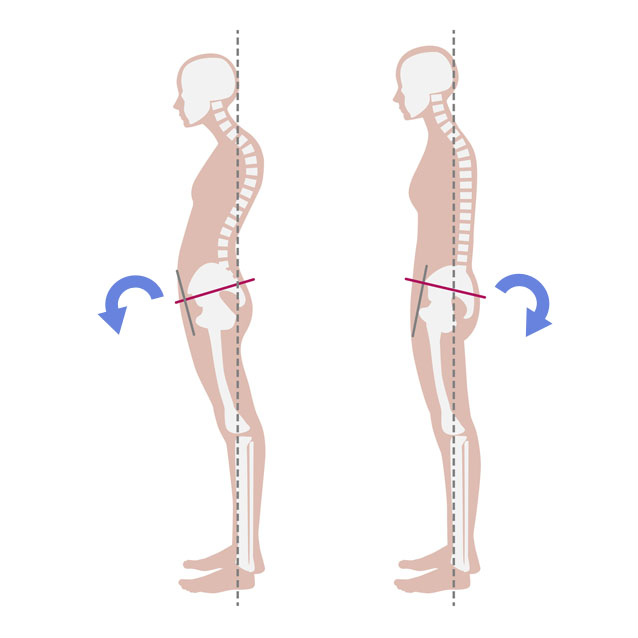
The Hips in Tai Chi - Psoas Muscle and the Pelvis
Read my article on the psoas, a deep internal muscle within the pelvis. Learn how a tight psoas muscle can pull your skeleton out of alignment into anterior hip tilt, impede your breathing ability and is related to the fight or flight response and your emotional health.
The Hips in Tai Chi - Spine Connection
It is impossible to talk about the pelvis without involving the rest of the spine, as alignment is a whole body quality, it is not isolated.
In Tai Chi there are five bows within the physical structure. Two in the legs, two in the arms, and one across the whole spine from top to bottom. The caveat is when considering the concept of the spine as a bow, this does not mean hunching or creating a flexed shape in the spine. Instead, the spine is aligned between the two acupuncture points; bai hui (crown point DU20) and hui yin (perineum point Ren1). A straight line is maintained between the two points.
This means to move the spine into a position where the pelvis is neutral, the ribs are folded inwards, the chest is not flaring, the shoulders are not collapsed forwards and the forward head curve in the neck is brought upright. This creates a straighter spine. There is still the presence of a natural curve in the spine, however not to excess anywhere along the spine.
Straightening the spine also means to lengthen and expand the spine from the ground upwards. Read my two articles on spine health and the principle Ding in Tai Chi (spine alignment) which discuss the body mechanics in detail.
The Hips in Tai Chi - Breathing
If the pelvis is misaligned this has an impact on the position and function of the diaphragm muscle and the pelvic floor muscles. In Traditional Chinese Medicine the diaphragm and pelvic floor are described as two plates, with the parachute shape of the diaphragm matching the pelvic floor hammock shape. These plates stack horizontally and move together during breathing. In the relaxation breath, also called Buddhist or abdominal breathing. When inhaling the diaphragm contracts down and the pelvic floor relaxes down, both moving in a downward direction. When exhaling, the diaphragm relaxes upwards and the pelvic floor contracts upwards, both moving in an upward direction.
An example of how alignment can affect your breathing. With the pelvis in anterior tilt, the pelvic floor is in a slanted down position, which compromises the integrated movement with the diaphragm.
The Hips in Tai Chi - Martial Power
Tai Chi works as a martial art by body mechanics not muscle force. Applying, developing and maintaining the body mechanics in Tai Chi is crucial to being able to absorb, deflect and generate martial strength or power. Misalignment of the pelvis or spine results in weakness. An excessive lumbar curve would create a poor posture martially. Testing your posture in standing poses (zhan zhuang) and during movement (push hands) is essential to understanding how the body mechanics work when pressure is applied to your structure. The body never lies, if the alignment is poor, you can’t fake body mechanics. It would take feather light pressure to demonstrate the weakness in a poor posture. Read more in my article on the principle of rooting/grounding, peng jin and fang song to understand more about the body mechanics required for martial power.
The Hips in Tai Chi - The Kua / Kwa
In Chinese, the kua describes the inguinal crease area and a specific function of body mechanics in Tai Chi training. This is part of the hip principle in Tai Chi, and is a large subject of discussion, coming soon.
The Hips in Tai Chi - As with all medical conditions, injuries and/or ill-health, please consult with your Doctor prior to starting a class. Tai Chi, Qigong and Meditation are not a replacement for conventional medical treatment. This article is for information purposes only and must not be taken as medical advice.
